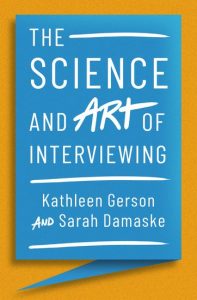In The Science and Art of Interviewing, Kathleen Gerson and Sarah Damaske offer a new overview of why interviewing is a useful and powerful research tool and how we can make better use of it. Guiding us through the process, from identifying our research questions to reporting our findings, this book makes a compelling case for interviewing as a research method, writes M Kerem Coban.
The Science and Art of Interviewing. Kathleen Gerson and Sarah Damaske. Oxford University Press. 2021.
 Find this book (affiliate link):
Find this book (affiliate link):![]()
In a recent chat, a colleague asked why interviewing is my favourite method. I have two main reasons, which Kathleen Gerson and Sarah Damaske capture at the very beginning of their book, The Science and Art of Interviewing. First, interviews allow us to ‘map and analyse mental processes, private activities, and social arrangements so taken for granted that they remain imperceptible’ (6). Second, we can explore new phenomena that we may overlook or ignore, shedding light on ‘macro-micro links’ (7). These are particularly gathered through first-hand observation, where interviews point to ‘how people talk about themselves and others […] how people construct accounts to explain actions and beliefs, and the social contexts that shape these accounts’ (19).
Interviewing is not only ‘talking to people’ or ‘listening to people’. If there is no such thing as mastering this powerful tool, we can at least ‘tame the beast’ to serve our goals and objectives. Gerson and Damaske not only tell us why interviewing is both a science and an art – through exploring its rules, norms and processes, and by discussing their experience, insights, observations and examples arising from the existing literature. They also complement such information and knowledge with templates. Gerson and Damaske provide a concise and insightful call to understand why interviewing is a useful and powerful tool and how we can make better use of it.

Photo by Daniel Robert Dinu on Unsplash
The authors help us to go through the initial stages of interviewing, such as constructing an interview guide. In Chapter Two, the authors note that the interview guide should consist of questions that are not designed to get preferred answers as we are driven to explore the unexplored. Depending on our particular research, the guide should be designed to address various dimensions, such as macro-micro dynamics, dynamic processes and individual experiences. Furthermore, if interviews include distinct groups, cross-checking the same facts based on the identities of those individuals or groups is effective for drawing a clearer picture, which could be based on conflicting accounts. Additionally, the authors note that the guide could be designed to test existing theories and/or develop new theories or concepts (39-44). For this, an abductive approach could be useful given that interviews have two sides: being driven by existing debates and also ‘letting the data speak’.
Next, the authors take us to the question of ‘interviews with whom?’ Students and researchers may worry about the size of their interview sample. Yet ‘there is no such thing as a perfect sample’ (47). What matters in sampling is ‘to find a sample that will lead others to have confidence in the soundness and importance of your findings’ (47). I would agree with this claim, but it is not only what readers, editors and reviewers think about the reliability of our data. For in-depth treatment of our research puzzles, we need to interview key groups or individuals. An ‘ideal sample’ is not who we could best possibly ‘recruit’; rather, we need to strive to ‘recruit’ key actors with the most direct experience, role and/or influence.
Having the best possible sample can be most effectively instrumentalised by an interview guide that is flexible and allows for in-depth treatment of our research questions. The simple rule of a ‘good guide’ is giving it a flexible structure. This means that we know what to ask and even when to ask but also to be open to exploring new paths, as each interview may not only address what we want to know but can also lead us to unexpected data that may emerge.
To give an example, I had a roadmap before landing in the field for my PhD research. However, as I interviewed public officials, I noticed that the ‘reality’ was different. I had to update the guide with different questions and even ask for more elaboration to get immersed in this unexpected puzzle. Designing and incorporating flexibility into the interview guide means going back-and-forth between planning for and conducting the interview.
As I noted above, an abductive approach can be useful here: as we prepare the interview guide based on our priors and our reading of existing debates and literature, the data in the field may impose itself. At the same time, the wording of questions will influence the quality of our data as questions determine construct validity, and therefore the relevance and strength of our measurements. For example, if you want to know about bureaucratic politics, the interview guide will include questions about interactions and relationships between public organisations. Here, you do not only ask questions; the answers you receive as well as probes into the main interview questions listed in the interview guide help with asking ‘nested interview questions’. Answers to the main research questions generate subsequent interrelated interview questions (80-82). As we probe and try to address our research questions, designing the interview guide based on a chronological order that moves from past to present to future might also be a useful technique, as the authors note (83-96).
Once we reach the stage of conducting the interview, the authors note that pre-testing is a useful strategy to have a ‘secure zone’ in which to learn about one’s interview style and the potential reactions of future interviewees. Indeed, pre-testing can contribute to the interview guide by testing the relevance of the questions as well as making sense of the validity of our questions to measure variables insofar as we consider the possibility of distinct dynamics, mechanisms or factors that might be at play in the field.
Contacting potential interviewees is crucial to ‘recruit’ them and build mutual trust before meeting. For this, we need to justify the rationale, their rights and our responsibilities to them, as well as how anonymity will be ensured. Once we secure the meeting and conduct the interview, the authors note that a fruitful interview depends on asking consistent, coherent questions, active listening and constant probing. This is because an interview could be one’s sole shot at speaking to the participant. Moving from interview to interview is another opportunity to reflect on your research puzzles and what else might be asked in the next interview. Finally, knowing about the context, asking interviewees about their preferences on the location, the duration and when to switch on the recorder, among others, can be fundamental not only for securing a meeting but also for data quality.
The authors discuss analysing interviews in Chapter Six. Laborious but boring transcription must be ‘enjoyed’ before proceeding to the analysis. Coding is the technique to make sense of thousands of words and hundreds of pages of transcribed interviews. Choosing between theoretical coding, open coding or focused coding will depend on one’s objectives. However, there is the danger of inflicting our biases, which may divert our interpretation towards our preferred mechanisms and factors even when they do not have strong empirical grounds. This may even emerge due to our socialisation with interviewees as we spend more and more time in the field and begin to conceive the world through their lenses.
Finally, once we reach the reporting of our results, the vast written dataset at hand will drive us to report most, if not all of it. But informative, transparent and reliable reports require hard and selective choices about quotes, reporting numbers or shares of (dis)agreed outcomes rather than making claims such as ‘many officials’ or ‘the majority of our interviewees’, as well as ensuring consistency between theoretical, conceptual and empirical aspects.
All in all, The Science and Art of Interviewing has two substantial achievements. First, it makes a compelling case for interviewing. It convinces us that it is a powerful tool to uncover rarely observed or even taken-for-granted phenomena given that interviews facilitate ‘opening the black box’ of individual or organisational processes that are otherwise difficult to observe. Metaphorically speaking, they allow us to get into the kitchen where the dish is being cooked and talk to many different actors that take part in the process. Through this, we get to know key actors, interact with them and uncover processes through their experiences. Second, as interviewing is a laborious, demanding task and process, from identifying our research puzzles to reporting our findings, this book guides us through constructing the road to the end of the research tunnel where enlightenment may dazzle us.
Note: This review gives the views of the author, and not the position of the LSE Review of Books blog, or of the London School of Economics and Political Science. The LSE RB blog may receive a small commission if you choose to make a purchase through the above Amazon affiliate link. This is entirely independent of the coverage of the book on LSE Review of Books.







